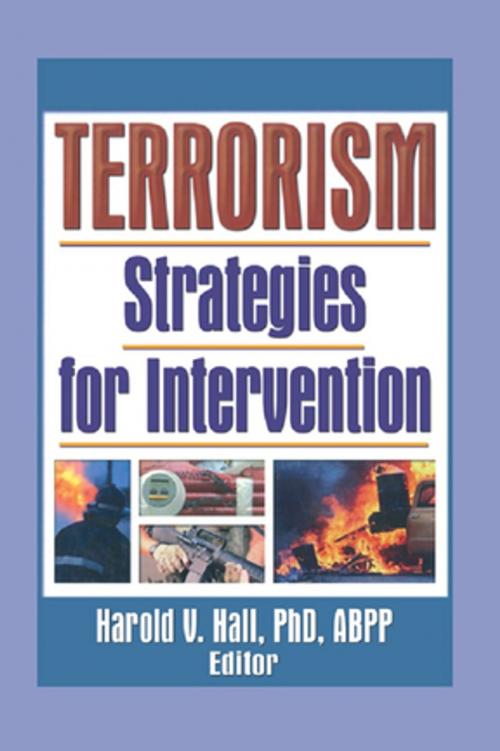Terrorism
Strategies for Intervention
Nonfiction, Social & Cultural Studies, Social Science, Crimes & Criminals, Criminology, Sociology, Political Science| Author: | Harold Hall V | ISBN: | 9781136417719 |
| Publisher: | Taylor and Francis | Publication: | February 1, 2013 |
| Imprint: | Routledge | Language: | English |
| Author: | Harold Hall V |
| ISBN: | 9781136417719 |
| Publisher: | Taylor and Francis |
| Publication: | February 1, 2013 |
| Imprint: | Routledge |
| Language: | English |
An essential resource for anyone working against terrorism in any form it may take!
Written for threat assessment professionals in the post-9/11 era, this timely book will help you understand the motivation to commit acts of terror, the thinking patterns common to many terrorists, the psychology of Muslim fundamentalists, methods for predicting the likelihood of chemical/biological attacks, and a great deal more. You’ll learn about hostage/barricade situations and the role of the crisis negotiator, including victim/perpetrator psychology and factors that indicate progress is being made in a crisis negotiation and factors that imply imminent lethality.
After reading Terrorism: Strategies for Intervention, you’ll have a better understanding of:
- biological, social, and psychological constructs that are important to understanding group violence
- the role of emotions in violence
- the history of chemical/biological weapons use from 1978 to the present, and methods of predicting the likelihood and origins of such attacks
- the importance of concurrent sequences in relation to chemical/biological attacks
- hostage/barricade situations, the makeup of crisis negotiation teams, and the role of the crisis negotiator
- hostage incident databases-where to find them, what they contain, and how they can be used effectively
- six different types of hostage takers and what strategies have the best chance of bringing each type’s crises to an end
- factors that indicate progress is being made in a crisis negotiation and factors that imply imminent lethality
- ethical concerns for forensic consultants when dealing with the issues surrounding terrorism
Here is a sample of what you’ll find in this informative and well-referenced book:
Terrorism as Group Violence illustrates the complexity of terrorism and the need to consider the interplay of biological, social, and psychological influences on terrorist behavior. This chapter identifies the constructs and data generated by theories of violence that are relevant to terrorism. Next, profiles of terrorists’ motivations are scrutinized, followed by a probing of the specific patterns of thinking salient to their motivations. Finally, approaches to solving the terrorist problem are framed. Five handy tables make important points easy to access and understand.
Chemical and Biological Violence: Predictive Patterns in State and Terrorist Behavior is essential reading for any serious evaluator of chemical and biological weapons. This chapter uses the Lethal Violence Sequence as a means to help predict chemical/biological weapons use by religious and ethno-nationalist terrorist groups. It includes case vignettes, data categories that can help make predictions more accurate, and a discussion of solutions for use by individuals, law enforcement and federal anti-terrorist agencies, as well as manufacturers and other industry entities, plus a consideration of government and international efforts.
Negotiating Crises: The Evolution of Hostage/Barricade Crisis Negotiations examines multiple ways by which a crisis incident can be classified, analyzes the results of hostage incident databases, discusses negotiation techniques, and explores the impact of captivity on the victim. The author reveals important characteristics of hostage/barricade situations that can be vital to the success of the evaluator/negotiator. Six informative tables in this section make statistics and procedures easy to understand.
Ethical Concerns in Forensic Consultation Regarding National Safety and Security provides an essential overview of the ethical challenges that mental health professionals and behavioral scientists face when they consult on matters of national security and safety. This chapter delivers useful guidance for professionals who
An essential resource for anyone working against terrorism in any form it may take!
Written for threat assessment professionals in the post-9/11 era, this timely book will help you understand the motivation to commit acts of terror, the thinking patterns common to many terrorists, the psychology of Muslim fundamentalists, methods for predicting the likelihood of chemical/biological attacks, and a great deal more. You’ll learn about hostage/barricade situations and the role of the crisis negotiator, including victim/perpetrator psychology and factors that indicate progress is being made in a crisis negotiation and factors that imply imminent lethality.
After reading Terrorism: Strategies for Intervention, you’ll have a better understanding of:
- biological, social, and psychological constructs that are important to understanding group violence
- the role of emotions in violence
- the history of chemical/biological weapons use from 1978 to the present, and methods of predicting the likelihood and origins of such attacks
- the importance of concurrent sequences in relation to chemical/biological attacks
- hostage/barricade situations, the makeup of crisis negotiation teams, and the role of the crisis negotiator
- hostage incident databases-where to find them, what they contain, and how they can be used effectively
- six different types of hostage takers and what strategies have the best chance of bringing each type’s crises to an end
- factors that indicate progress is being made in a crisis negotiation and factors that imply imminent lethality
- ethical concerns for forensic consultants when dealing with the issues surrounding terrorism
Here is a sample of what you’ll find in this informative and well-referenced book:
Terrorism as Group Violence illustrates the complexity of terrorism and the need to consider the interplay of biological, social, and psychological influences on terrorist behavior. This chapter identifies the constructs and data generated by theories of violence that are relevant to terrorism. Next, profiles of terrorists’ motivations are scrutinized, followed by a probing of the specific patterns of thinking salient to their motivations. Finally, approaches to solving the terrorist problem are framed. Five handy tables make important points easy to access and understand.
Chemical and Biological Violence: Predictive Patterns in State and Terrorist Behavior is essential reading for any serious evaluator of chemical and biological weapons. This chapter uses the Lethal Violence Sequence as a means to help predict chemical/biological weapons use by religious and ethno-nationalist terrorist groups. It includes case vignettes, data categories that can help make predictions more accurate, and a discussion of solutions for use by individuals, law enforcement and federal anti-terrorist agencies, as well as manufacturers and other industry entities, plus a consideration of government and international efforts.
Negotiating Crises: The Evolution of Hostage/Barricade Crisis Negotiations examines multiple ways by which a crisis incident can be classified, analyzes the results of hostage incident databases, discusses negotiation techniques, and explores the impact of captivity on the victim. The author reveals important characteristics of hostage/barricade situations that can be vital to the success of the evaluator/negotiator. Six informative tables in this section make statistics and procedures easy to understand.
Ethical Concerns in Forensic Consultation Regarding National Safety and Security provides an essential overview of the ethical challenges that mental health professionals and behavioral scientists face when they consult on matters of national security and safety. This chapter delivers useful guidance for professionals who















